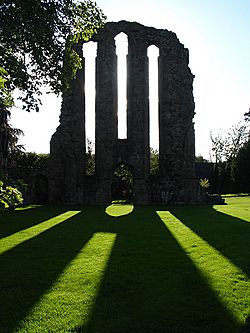Croxden Abbey facts for kids
 |
|
| Monastery information | |
|---|---|
| Other names | The abbey of the Vale of St. Mary of Croxden |
| Order | Cistercian |
| Established | 1179 |
| Disestablished | 1538 |
| Dedicated to | Virgin Mary |
| People | |
| Founder(s) | Bertram III de Verdun |
| Site | |
| Location | Croxden, Staffordshire, United Kingdom |
| Public access | Yes |
Croxden Abbey, also known as "Abbey of the Vale of St. Mary at Croxden", was a Cistercian abbey in Croxden, Staffordshire, United Kingdom. It was like a "daughter house" of a larger abbey in Normandy, France. Bertram III de Verdun from Alton Castle founded this abbey in the 12th century. The abbey was closed down in 1538 during a time called the Dissolution of the Monasteries.
Contents
Discovering Croxden Abbey's Past
How Croxden Abbey Began
In 1176, a nobleman named Bertram III de Verdun gave land for a new abbey. He gave it to 12 Cistercian monks from Aunay-sur-Odon, Normandy. Bertram founded the abbey for his family's spiritual well-being. He wanted the monks to pray for his parents and for himself and his wife.
The monks first stayed near Alton until 1179. Then they moved to land near Croxden, a few miles south. Bertram de Verdun also gave the abbey more land in different counties. These included Staffordshire, Cheshire, Derbyshire, and Leicestershire. He also gave them churches and chapels.
Growing and Prospering
The abbey continued to grow in the 13th century. King John gave the monks £5 every year from the Irish treasury in 1200. Later, he exchanged this for land in Adeney, Shropshire. Croxden Abbey was quite wealthy during this time. Most of its money came from raising sheep.
By 1315, the monks were selling more wool to Europe than any other religious house in the county. They traded with merchants from Florence, Italy, even into the 1420s. The abbey's wealth was clear when an abbot named William of Over bought a house in London for £20.
Challenges and Closure
By the 14th century, Croxden's money situation got worse. They faced royal taxes and had to pay back loans. There were also bad harvests and the plague, which made things harder.
In 1316, Theobald II de Verdun, the last male heir of the founding family, died. The abbey's ownership passed to his eldest daughter, Joan de Verdun. She married Thomas de Furnivall. There were serious arguments between the monks and de Furnivall. He was using abbey lands and property. In 1319, the monks even locked themselves inside the abbey for 16 weeks. They finally got their property back with help from other landowners.
The abbey's income was less than £200 per year. This meant it should have been closed under a law from 1535. This law said that religious houses with low incomes should be dissolved. However, the monks paid a fine of £100 to stay open. But in 1537, the abbey was finally given up. Its land and property were sold off. The king gave the monks pensions, which were like retirement payments. The last abbot received £26 13s. 4d each year.
Some old documents about the abbey's property from before it closed are kept at the Cadbury Research Library.
What Happened After the Closure?
A chapel from the mid-13th century survived. It was used as the local church for Croxden until 1886. A new church was built nearby. In 1936, the site came under the care of the government. Today, English Heritage looks after it. Many parts of the abbey buildings are still standing. Thanks to excavations in 1968, you can also see the foundations of some buildings that were taken down.
Abbey Design and Buildings
The church's design was based on the abbey's "mother church" in Aunay-sur-Odon. Its style was more detailed than most Cistercian buildings. The west wall, with two doorways and windows above them, is still mostly complete.
The monks' living and service buildings were south of the church. These included a sacristy (where sacred items were kept), a chapterhouse (for meetings), a kitchen, and a dormitory (sleeping area). The upper floors, which had the dormitory and a treasury (for valuables), are no longer there.
The Uttoxeter Casket
The Uttoxeter Casket, also called Dr Nelson's Casket, is an Anglo-Saxon container. It likely came from Croxden Abbey. It probably held a religious relic and was displayed on an altar. Today, the casket is in the Cleveland Museum of Art in Ohio, USA.
Important Burials at Croxden Abbey
- Bertram III de Verdun, who founded the Abbey.
- Rohese de Verdun (also known as 'Rohais'), wife of Bertram III de Verdun.
- Theobald de Verdun, 2nd Baron Verdun, a later member of the founding family.
- Matilda Mortimer, Theobald de Verdun's first wife.
Images for kids


